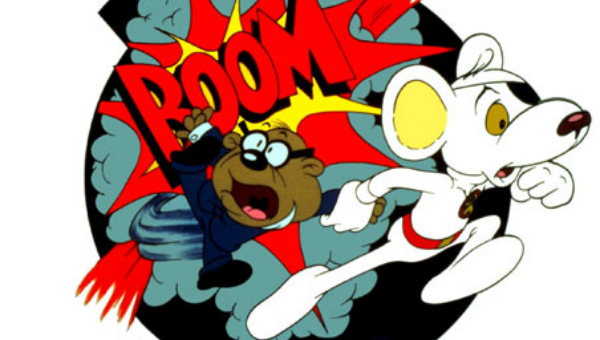 DANGER MOUSE is a relic of a time when the UK had only three (count them, three) national television channels, and even those were not doing anything useful much of the day. As a result, although the shows are energetic and busy, there isn’t the overwhelming pressure to distract the viewer from the channel changer until the next commercial slot.
DANGER MOUSE is a relic of a time when the UK had only three (count them, three) national television channels, and even those were not doing anything useful much of the day. As a result, although the shows are energetic and busy, there isn’t the overwhelming pressure to distract the viewer from the channel changer until the next commercial slot.
Which is not to say that DANGER MOUSE belongs to some sun-dappled innocent age where people left their doors unlocked at night and borrowed sugar from one another on a regular basis. It was a commercial product aired on commercial television; it’s simply that the makers allow themselves time to tell a story, however surreal and disjointed. And they do tell the story. Danger Mouse, Penfold and the Baron spend an awful lot of time in between action sequences rehearsing the plot (much as the characters in opera often do), and Colonel K. has no other function. But that’s right for the spy caper idiom too.
Danger Mouse tends, much like his contemporary incarnation of Dr. Who, to spend a lot of time running down corridors.
Of course, texture-less characters standing still against a stationary background with only their mouths moving are a lot cheaper to animate than ones swerving through lovingly rendered spaces with depth and movement of their own. A commercial enterprise, you see. Walking through the darkness with only your eyes visible might even be cheaper, so there’s plenty of that. Danger Mouse tends to move in straight lines at uniform speed. Danger Mouse tends to walk in front of, and parallel to, flat walls. Danger Mouse tends to deal with protagonists who all look the same as one another. Danger Mouse tends, much like his contemporary incarnation of Dr. Who, to spend a lot of time running down corridors. In a straight line at constant speed.
Because DANGER MOUSE is also a relic of a time, the early to mid 1980s, when there wasn’t a lot of money around (unless you were in the first wave of Stock Exchange deregulation fat-cats). Thatcher was busy selling off the nation’s infrastructure and shutting down industries that tended to employ Labour voters. There were three million on the dole, police cavalry charging striking miners and the IRA blowing up Harrods. All against the backdrop of the last, desperate, insane decade of the Cold War. Maybe recycled silent movie sight-gags and music-hall jokes were what the youth of the nation needed. Maybe the channel changer wasn’t what we needed distraction from.
httpvh://youtu.be/Umh2GID1GPM

